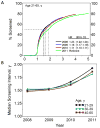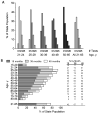A population-based evaluation of cervical screening in the United States: 2008-2011
- PMID: 24302677
- PMCID: PMC4011954
- DOI: 10.1158/1055-9965.EPI-13-0973
A population-based evaluation of cervical screening in the United States: 2008-2011
Abstract
Background: Cervical screening consumes substantial resources, but little is known about utilization in the United States or compliance with guideline recommendations.
Methods: To describe population screening coverage, utilization, and outcomes and examine time trends from 2008 to 2011, cervical cytology reports from women residing in New Mexico (981,063 tests from 511,381 women) were evaluated.
Results: From 2008 to 2011 cervical screening utilization decreased at all ages, but especially in younger women, with a two-third reduction at ages 15 to 20 years. Ninety-four percent of women ages 25 to 29 years were screened within 48 months but coverage decreased at older ages to 69% at 45 to 49 years and 55% at 60 to 64 years. Intervals between screening tests were significantly longer in 2011 compared with 2008 [HR = 1.23; 95% confidence intervals (CI), 1.22-1.24], although the commonest rescreening interval was 13 months. In 2011, 91.9% of screening tests for women ages 21 to 65 years were negative, 6.6% showed minor abnormalities, and 1.0% high-grade abnormalities. High-grade abnormality rates were relatively constant over time, but minor abnormalities and atypical cells cannot rule out high-grade (ASC-H) were increasing.
Conclusions: This population-based evaluation of cervical screening shows high coverage under the age of 40 years, but lower levels in older women. Screening under age 21 years is becoming less common and screening intervals are lengthening, reflecting updates in national screening guidelines.
Impact: Assessment of cervical screening intervals and population outcomes is essential for accurately estimating the impact and effectiveness of changing recommendations and vaccination against human papilloma virus infections.
©2013 AACR.
Figures




References
-
- Sasieni P, Cuzick J, Farmery E. Accelerated Decline in Cervical Cancer Mortality in England and Wales. Lancet. 1995;346:1566–7. - PubMed
-
- Laara E, Day NE, Hakama M. Trends in mortality from cervical cancer in the Nordic countries: association with organized screening programmes. Lancet. 1987;1:1247–49. - PubMed
-
- IARC Working Group. IARC Handbooks of Cancer Prevention, International Agency for Research on Cancer, World Health Organization. IARC Press; 2005. Cervix cancer screening.
Publication types
MeSH terms
Grants and funding
LinkOut - more resources
Full Text Sources
Other Literature Sources
Medical
Miscellaneous

